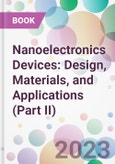Topics Covered in Part 2 include applications of nanoelectronics for different devices and materials.
- Photonic crystal waveguide geometry
- 8kW to 80kW power grids with simple energy storage systems
- Two-dimensional material and based heterojunctions like MoS2 /graphene, MoS2 /CNT, and MoS2 /WS2,
- 5G communication material
- Wearable devices like electronic skin, intelligent wound bandages, tattoo-based electrochemical sensors
- PEDOT: PSS-based EEG
- New materials for medicine
Audience
Researchers and industry professionals in the field of electronics and nanotechnology; students taking advanced courses in electronics and technology.Table of Contents
- Contents
- Preface
- Organization of Part Ii
- Acknowledgment
- List of Contributors
- Crystal Waveguide for Optical Interconnect Application With Signal
- Amplification
- Abinash Panda, Chandra Sekhar Mishra, Puspa Devi Pukhrambam and Malek
- Daher
- Introduction
- Photonic Crystal Waveguide (Pcw): Concept and Geometry
- One-Dimensional Photonic Crystal
- Two-Dimensional Photonic Crystal
- Three-Dimensional Photonic Crystal
- Controlling Factors of Photonic Crystals
- Mechanism of Photonic Crystal
- Index Guiding Mechanism
- Band Gap Mechanism
- Computational Methedology
- Finite Difference Time Domain (Fdtd)
- Various Defect-Based Photonic Structures
- Simulation Methodology
- Conclusion
- Multiple Choice Questions
- Answer Key
- References
- Sumithira T.R. And Ramesh Kumar
- Introduction to Nanotechnology
- Classification of Nanomaterials
- Method of Synthesis
- Nanotechnology in Electrical Engineering Applications
- Smart Nano Power Grid
- Identified Issues and Recommended Solutions
- Implication of Nanotechnology in Sng Components
- Solar Photo Voltaic Systems(Spv)
- Fuel Cells (Fc)
- Bio Energy
- Wind Energy
- Energy Storage Devices
- Electrical Transformers
- Electrical Insulators
- Smart Sensors
- Distribution Line Wires and Cables
- Power Semiconductor Devices
- Measuring and Communications Systems
- Reconfiguration and Restructuring of Nanogrid
- Challenges in Nt Applications to Sng
- Conclusion
- Learning Objectives
- Multiple Choice Questions
- Answer Key
- References
- Material for Artificial Retina Implant
- Ashish Tiwari, R.H. Talwekar and Ravi Kumar
- Introduction
- Biomaterial for Subretinal Implant
- Identified Materials for Photodetector/Photodiode
- Photodiode Based on Graphene
- Transition Metal Dichalcogenides (Tmds) Driven Pds
- Metal Oxide Semiconductors Driven Pds
- Proposed Material for this Work
- Methodology and Computational Details
- Basics of Density Functional Theory
- Performance of Local Density Approximation (Lda) and Generalised Gradient
- Approximations (Gga)
- Results and Discussions
- Structural Parameters
- Electronic Properties
- Optical Properties
- Dielectric Function
- Absorption Coefficient and Optical Conductivity
- Reflectivity
- Conclusion
- Learning Objectives
- Multiple Choice Questions
- Answer Key
- Acknowledgements
- References
- Circuit Architectures
- Kumar Saurabh and Sukwinder Singh
- Introduction to Fifth-Generation Mobile Communica-Tion
- Introduction to Power Amplifier
- Active Devices for Power Amplifier
- Different Classes of Power Amplifiers
- Class a Power Amplifier
- Class B Power Amplifier
- Class Ab Power Amplifier
- Class C Power Amplifier
- Class D Power Amplifier
- Class E Amplifier
- Class F Amplifier and Class F-1 Amplifier
- Comparison Between Class A, B, Ab, and C, D, E, and F Class Amplifiers
- Basics of Different Efficiency Enhancement Techniques
- Doherty Amplifier and Its Structure
- Types of Doherty Amplifiers
- Conclusion
- Learning Objectives
- Multiple Choice Questions
- Answer Key
- References
- Drishti Hans, Gaurav Narula and Kusum Tharani
- Introduction to Nanotechnology
- Nanotechnological Trends in Solar Industry
- Advantages of Nanotechnology
- Review of Nanotechnology in Solar Panel
- Nano Polymers and Nanocomposites
- Nanocomposites for Solar Panel
- Nano Polymeric Layers for Solar Panel
- Proposed Panel
- Structure of Nanocrystal Solar Cell
- Layers in Panel
- Frame
- Sio2 Tio2 Nanocomposite
- Pmma/Tio2
- Nanocrystal Solar Cell
- Backsheet
- Junction Box
- Comparative Analysis
- Conclusion and Future Scope
- Future Scope
- Learning Objectives
- Multiple Choice Questions
- Answer Key
- References
- For Medical Applications
- Kiran Singh Sharma
- Introduction
- Nanostructure Building Blocks
- Amorphous Polymers
- Semi-Crystalline Polymers
- Natural Polymers
- Polymeric Conductors
- Conductive Polymers
- Polypyrrole (Ppy)
- Polyaniline (Pani)
- Poly (3,4-Ethylenedioxythiophene) (Pedot)
- Poly (3-Hexylthiophene) (P3Ht)
- Polymeric Semiconductors
- Pedot-Pss
- Clip
- Conductive Polymer Composites
- Graphene
- Carbon Nanotubes (Cnts)
- Metallic Nanowires
- Silicon Nanowires
- Liquid Metals
- Application of Nanoelectronics Material in the Medical Field
- Wearable Devices
- Electronic Skin (E-Skin)
- Smart Wound Bandages
- Tattoo-Based Electrochemical Sensors
- Electroencephalography (Eeg)
- Implantable
- Electrocorticography (Ecog)
- Electrocardiography (Ecg)
- Electronic Stents (Es)
- Artificial Eyes
- E-Nose
- Electronic Bladder
- Electronic Liver
- Electronic Lungs
- Insertable
- Cybernetic Prosthetics
- Flexible Spinal Cord Implants
- Non-Invasive Brain-Machine Interfaces
- Retinal Prosthesis
- Cyborg Organic Constructs (Cyborganics)
- Conclusion
- Learning Objectives
- Multiple Choice Questions
- Answer Key
- Acknowledgment
- References
- Industry
- Swati Checker and Chitra Ramanan
- Introduction
- Background
- Nanotechnology in Dentistry
- Materials for Tissue Regeneration
- Dental Nanocomposites and Nanoparticles
- Dental Tissue Engineering Uses for Nanomaterials
- Nanotechnology in Surgical Intervention
- Nanotechnology in Orthopedic and Periodontal Therapy
- Biosensors Used in Dentistry
- Biosensor Concept & Their Types
- Oral Fluid-Based Biosensors
- Nanotechnology in the Cosmetics Industry
- Types of Nanomaterials Used in Cosmetics
- Cosmeceuticals
- Penetration of Nanoparticles Across the Skin
- Biosensors Used in Cosmetic Industry
- Conclusion
Author
- Gopal Rawat
- Aniruddh Bahadur Yadav








